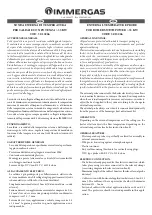
WHL-016 Rev. 4.14.16
16
Undersized expansion tanks cause system water to be lost
from the relief valve, causing make-up water to be added.
Eventual boiler failure can result due to excessive make-
up water addition.
SUCH FAILURE IS NOT COVERED BY
WARRANTY.
2. The expansion tank must be located as shown in
Applications, this manual, or following recognized design
methods. See expansion tank manufacturer’s instructions for
details.
3. Connect the expansion tank to the air separator only if the
air separator is on the suction side of the circulator. Always
install the system fill connection at the same point as the
expansion tank connection to the system.
4. Most chilled water systems are piped using a closed type
expansion tank.
DIAPHRAGM (OR BLADDER) EXPANSION TANK
Always install an automatic air vent on top of the air separator
to remove residual air from the system.
Expansion tanks must be sized according to total system
volume. This includes all length of pipe, all fixtures, boilers,
etc. Failure to properly size for system expansion could result
in wasted time, money, possible property damage, serious
injury, or death.
Expansion Tank Sizing
Model
Heat Exchanger Volume (Gallons)
055 / 080
2.2
110
2.6
155
6.2
199
6.1
285
6.1
399
7.9
Table 3 - Expansion Tank Sizing
DO NOT
install automatic air vents on closed type expansion
tank systems. Air must remain in the system and return to the
tank to provide an air cushion. An automatic air vent would
cause air to leave the system, resulting in improper operation
of the expansion tank.
E. Circulators
Sizing Space Heat System Piping
1. See Applications in this manual. In all diagrams, the space
heating system is isolated from the boiler loop by the primary/
secondary connection.
2. Size the piping and components in the space heating system
using recognized design methods.
DO NOT
use the boiler circulator in any location other than
the ones shown in this manual. The boiler circulator location
is selected to ensure adequate flow through the boiler.
Failure to comply with this caution could result in unreliable
performance and nuisance shutdowns from insufficient flow.
F. Hydronic Piping with Circulators, Zone Valves, and
Multiple Boilers
This boiler is designed to function in a closed loop hydronic
G. Circulator Sizing
Minimum Boiler Flow Rates
Model
Minimum Flow (GPM)
055
3.5
080
5.4
110
7
155
9.7
199
12.5
285
17.9
399
25
Table 4 - Minimum Flow Rates
In addition, the heat exchanger has a minimum total water
volume that must be taken into account when sizing the
circulator. Minimum flow rates are listed in the table below.
The heat exchanger has a pressure drop that must be considered
in your system design. Refer to Figure 7 for pressure drop
through the heat exchanger.
system. It is recommended to install a temperature and
pressure gauge (not included with the boiler) to allow the user
to monitor system pressure and outlet temperature from the
boiler. It is important to note that the boiler has a minimal
amount of pressure drop that must be calculated when sizing
the circulators. Unless the system has a closed type expansion
tank, each boiler installation must have an air elimination device
that will remove air from the system.
Install the boiler so the gas ignition system components
are protected from water (dripping, spraying, etc.) Allow
clearance for basic service of boiler circulator, valves and other
components.
Observe the minimum 1” clearance around all uninsulated hot
water pipes when openings around pipes are not protected by
non-combustible materials.
On a boiler installed above radiation level, some states and local
codes require a low water cut off device, which is an optional
part available through Westinghouse (Part # 7600P-104 for
55 – 110 models, 7600P-990 for 155 – 399 models). Check with
local codes for additional requirements. If the boiler supplies hot
water to heating coils in air handler units, flow control valves or
other devices must be installed to prevent gravity circulation of
boiler water in the coils during the cooling cycle.
Chilled water medium must be piped in parallel with, and
isolated from, the boiler. Freeze protection for new or existing
systems must use glycol that is specifically formulated for this
purpose. Antifreeze must include inhibitors that will prevent the
glycol from attacking the metallic system components. Make
certain that the system fluid is checked for the correct glycol
concentration and inhibitor level. The system should be tested
at least once a year and as recommended by the producer of the
glycol solution. Allowance should be made for the expansion of
the glycol solution in the system piping. Example: 50% by volume
glycol solution expands 4.8% in volume for a temperature
increase from 32
o
F to 180
o
F, while water expands 3% with the
same temperature rise.
Summary of Contents for WBC 399
Page 14: ...WHL 016 Rev 4 14 16 14 Figure 6 Boiler Dimensions NOTE All Dimensions Are Approximate 055 080 ...
Page 21: ...WHL 016 Rev 4 14 16 21 Figure 9 Piping Symbol Legend ...
Page 42: ...WHL 016 Rev 4 14 16 42 Figure 33 Internal Connection Diagram ...
Page 65: ...WHL 016 Rev 4 14 16 65 Figure 37 Combustion System Replacement Parts 55 110kBTU Models ...
Page 67: ...WHL 016 Rev 4 14 16 67 Figure 39 Combustion System Replacement Parts 155 399kBTU Models ...
















































